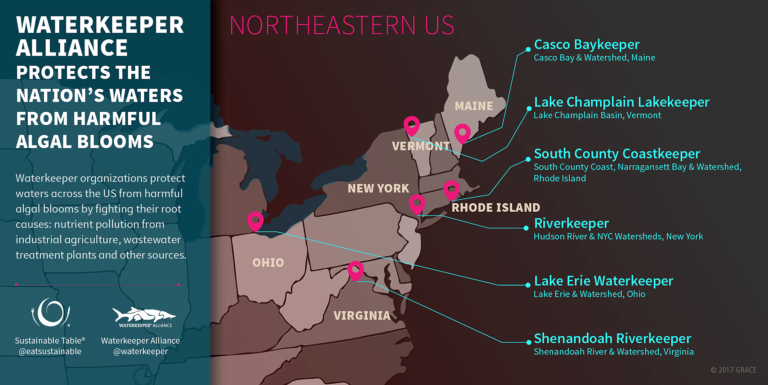
By Kai Olson-Sawyer | This post originally appeared on the Ecocentric blog and is reprinted with permission.
America’s waterways are as different and unique as its geography and people. From small streams, rural ponds and pocket wetlands to mighty rivers, great lakes and massive estuaries, the United States depends on the wealth of these waters for its public health and economic wellbeing. Yet as diverse as these water bodies are, many watersheds face the common problem of harmful algal blooms that hurt water quality and are caused by nutrient pollution.
On the frontlines of the battle against harmful algal blooms and nutrient pollution are local Waterkeepers — water protection organizations spread around the United States and the world. The 300-plus water protection groups constitute Waterkeeper Alliance, all of which are united to fight for people’s’ right to drinkable, fishable and swimmable water.
What Are Algal Blooms and Why Are They Bad?
Waterkeepers are well aware of nutrient pollution and aim to defend local waters that make up their watersheds. While nutrients are naturally occurring and necessary for aquatic life, they become pollution when excessive amounts of nitrogen and phosphorous enter waterways and produce a “bloom” of algae in either fresh or saltwater. This contamination comes from a host of human sources, such as agriculture, urban runoff and sewer and septic systems. Algal blooms are a threat to water quality as they can produce toxins hazardous to animals, humans, aquatic species and ecosystems. Blooms also deplete the water’s’ dissolved oxygen levels after the algae dies, which then creates dead zones that harm aquatic life and disrupt ecosystems. Two of the largest and most-recognized harmful algal blooms in the US are those recurring in Lake Erie and the Gulf of Mexico, the latter measured as the biggest ever in 2017.
The problem of harmful algal blooms affects all 50 states and is widespread because nutrient pollution is difficult to escape. According to the US Environmental Protection Agency, more than 40 percent of US streams and rivers had elevated levels of nitrogen or phosphorus; over 35 percent of freshwater lakes surveyed were negatively impacted by nutrient pollution; and greater than two-thirds of US coastal regions and over one-third its estuaries were impaired by nutrient pollution. The reason that this pollution is so prevalent is due to its many sources, which include fertilizer runoff from farm fields and runoff or leaks from animal agriculture manure lagoons; wastewater treatment plant releases; faulty septic systems; fertilizer runoff from residential lawns; and manufacturing wastewater discharges. As EPA states, while there are many sources of nutrient pollution, agricultural runoff related to animal manure, crop fertilizers and soil erosion make it one of the largest sources.
Waterkeepers from Coast to Coast
Waterkeepers are working to keep US waters safe from coast-to-coast — and everywhere in between. See where the Waterkeepers are, what they’re doing to stop nutrient pollution at the source as well as a few notable case studies.
Western US
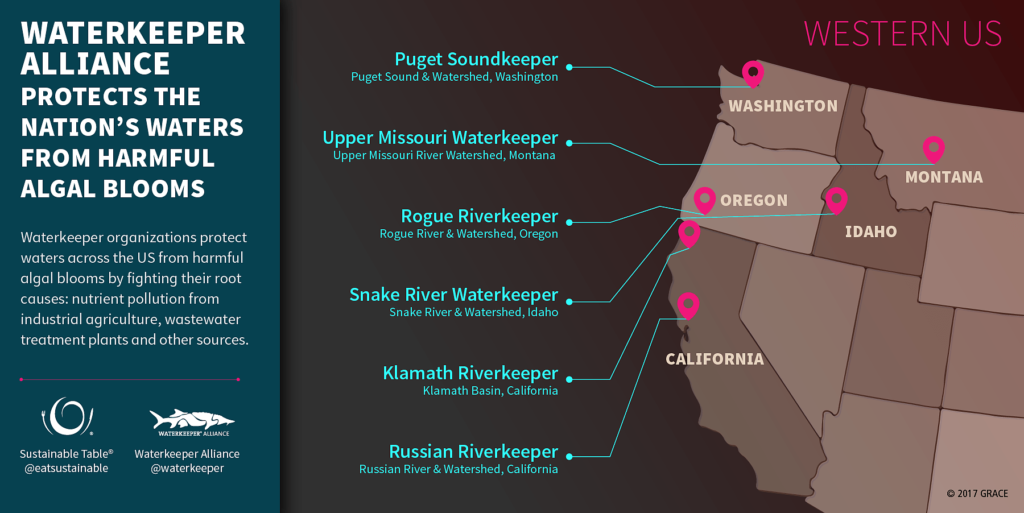
Download Western US map [159k]
Upper Missouri Waterkeeper, Upper Missouri River Watershed, Montana
The Upper Missouri Waterkeeper is a watchdog in the watershed keeping an eye out for pollution from coal and hard rock mining, oil and gas development and nutrient runoff from agriculture, among other sources.
Snake River Waterkeeper, Snake River and Watershed, Idaho
The Snake River Waterkeeper fights periodic harmful algal blooms in the Snake and the rest of the watershed that results from nutrient pollution and wetlands loss associated with the region’s large agricultural sector.
Rogue Riverkeeper, Rogue River and Watershed, Oregon
The Rogue Riverkeeper monitors the basin’s water to prevent bacterial and nutrient contamination from leaky septic tanks, irrigation return flows and cattle runoff, among other sources.
Klamath Riverkeeper, Klamath Basin, California
The Klamath Riverkeeper is focused on harmful algal blooms largely caused by agricultural runoff and compounded by the Klamath River dams that slow and heat up the waters in the reservoirs. As a result, the dams release some of the highest concentrations of toxic algae worldwide.
Russian Riverkeeper, Russian River and Watershed, California
The Russian Riverkeeper guards against large summer outbreaks of blue-green algae, some of which can produce toxins, and works to prevent urban runoff, lawn fertilizers and other sources from contaminating the river.
Puget Soundkeeper, Puget Sound and Watershed, Washington
The Puget Soundkeeper’s watershed includes about 1,200 animal factory farms that are lightly regulated and release huge amounts of nutrient-heavy manure into groundwater and other waterbodies. This degrades drinking water and contaminates the Puget Sound.
Chris Wilke, Puget Soundkeeper: In Puget Sound, the presence of toxins from harmful algal booms along the U.S. west coast has resulted in fishery closures, which can have tremendous economic and ecological impacts. In May 2015, the razor clam fishery in Washington State closed resulting in an estimated $9.2 million in lost income. The state’s commercial crab fishery, worth roughly $84 million annually, has also been affected. Nutrient pollution, which feeds harmful algal blooms in Puget Sound comes from various sources, including wastewater treatment plants, septic systems, agricultural discharges, Atlantic salmon net pens and industrial sites. Known locally as red tides, these are most commonly associated with shellfish poisoning in saltwater, which can severely sicken or kill birds, mammals and people that eat tainted shellfish.
Harmful algal blooms also result in hypoxic (low oxygen) and anoxic (zero oxygen – aka: dead zones) conditions. Puget Soundkeeper works to address nutrient pollution sources that cause toxic algal blooms by strengthening pollution permits, legally appealing weak permits and enforcing the law when state and federal agencies refuse to act. Puget Soundkeeper has filed over 175 actions to enforce Clean Water Act permits and have never lost a case. To date $5.3 million has been awarded to third-party organizations. Many (but not all) of these cases involve specifics around nutrient pollution, may result in reductions of nutrient pollution due to ancillary benefits from enhanced pollution prevention measures. Puget Soundkeeper routinely patrols agricultural areas to monitor visual sources of pollution, tests water for nitrates, and reports problems to state agencies. The organization also works to communicate the problem and educate the public through our new education series Pint-Size Science (scientific presentations in local pubs) and through participation in an important educational effort at www.whatsupstream.com
Central US
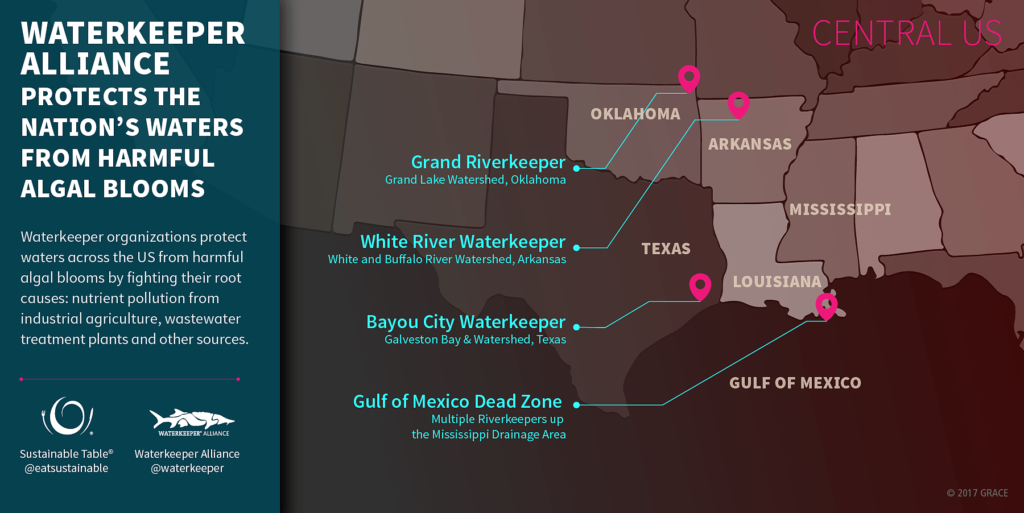
Download Central US map [160k]
Bayou City Waterkeeper, Galveston Bay and Watershed, Texas
The Bayou City Waterkeeper watches the Galveston Bay watershed – people living near this watershed encompass almost half of the population of Texas. The Galveston Bay watershed is facing huge losses of wetlands that filter out nutrients and other contaminants. [NOTE: Follow Bayou City Waterkeeper on Facebook as they and the rest of the Houston metro area recover from Hurricane Harvey.]
White River Waterkeeper, White and Buffalo River Watershed, Arkansas
The White Riverkeeper protects the White and Buffalo Rivers, noted for their beauty and recreational values, which are threatened by pollution from large hog factory farms.
Grand Riverkeeper, Grand Lake Watershed, Oklahoma
The Grand Riverkeeper and its watershed face higher water temperatures from climate change along with drought and flood cycles. This washes fertilizers and nutrients from cattle and other sources into the watershed and trigger major harmful algal blooms and bacteria outbreaks.
Multiple Waterkeepers up the Mississippi Drainage Area, Gulf of Mexico Dead Zone
There are numerous Waterkeepers protecting waters in the Mississippi River Basin, many with a particularly strong effort to keep fertilizers, agricultural runoff and other nutrients sources from contributing to the massive Gulf of Mexico dead zone.
Southeastern US
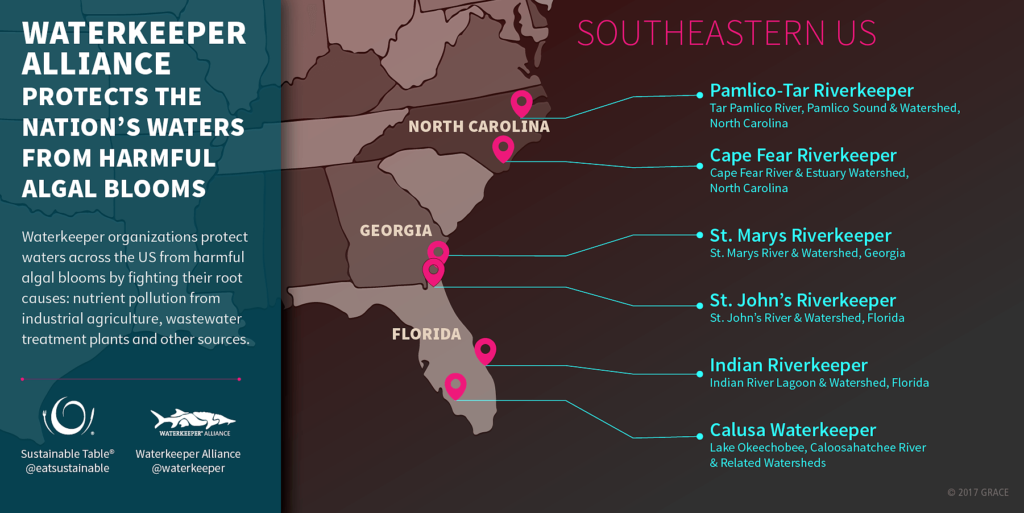
Download Southeastern US map [149k]
St. Marys Riverkeeper, St. Marys River and Watershed, Georgia
The St. Marys Riverkeeper monitors the river’s watershed which covers Florida and Georgia, and helps to maintain the impressive forests and wetlands that act as filtration from its Okefenokee Swamp headwaters.
Indian Riverkeeper, Indian River Lagoon and Watershed, Florida
The Indian Riverkeeper contends with large volumes of nutrient-laden water that enters the lagoon at all points, resulting in harmful algal blooms, turbidity and a severely deteriorated ecosystem with loss of seagrass, oyster beds, mangroves and many aquatic species.
St. John’s Riverkeeper, St. John’s River and Watershed, Florida
The St. John’s Riverkeeper fights harmful algal blooms regularly as contaminants from wastewater treatment plants, industrial discharges, failing septic tanks, storm water runoff and agriculture all wash into the river.
Calusa Waterkeeper, Lake Okeechobee, Caloosahatchee River and Related Watersheds
The Calusa Waterkeeper has experienced tremendous problems with water quality because of harmful algal blooms and their toxins, as agricultural runoff, septic systems and releases from Lake Okeechobee have had deleterious effects on ecosystems and drinking water.
Pamlico-Tar Riverkeeper, Tar Pamlico River, Pamlico Sound and Watershed, North Carolina
The Pamlico-Tar Riverkeeper has long dealt with excessive nutrient pollution causing algal blooms and dead zones in the sound, mainly due to overdevelopment and damaging runoff.
Cape Fear Riverkeeper, Cape Fear River and Estuary Watershed, North Carolina
The Cape Fear Riverkeeper’s river basin contains more factory farms than almost any other place on the planet due to the hundreds of millions of animals produced there annually, and with them, enormous pollution problems, including over-nutrification and algal blooms.
John Cassani, Calusa Waterkeeper: In Florida, algal blooms caused by excessive, uncontrolled nutrient pollution have grown worse over the last 16 years – adversely impacting inland and coastal waters, as well as communities, drinking water supplies, recreation, fish and wildlife, and the tourism industry. Harmful algal blooms producing toxins are now a regular occurrence in waterways across the state, including Lake Okeechobee and the Caloosahatchee, which experience vast cyanobacteria blooms covering more than 50 square miles and microcystin toxins at levels greater than 5,000 ug/l. As a result of a massive bloom in South Florida during the 2016 tourist season, a state of emergency was declared in Martin, St. Lucie, Palm Beach and Lee counties and blooms producing high levels of toxins are happening again this year. Florida Waterkeepers are calling on the Florida Legislature to reactivate and adequately fund the Florida Harmful Algal Bloom Task Force to start addressing this problem through adopting exposure standards, conducting science-based monitoring and public notification requirements. Calusa Waterkeeper is taking action to address sources of nutrient pollution, monitoring waters for HABs, reporting them to the Florida Department of Environmental Protection, and notifying the public through Facebook and the media.
Northeastern US
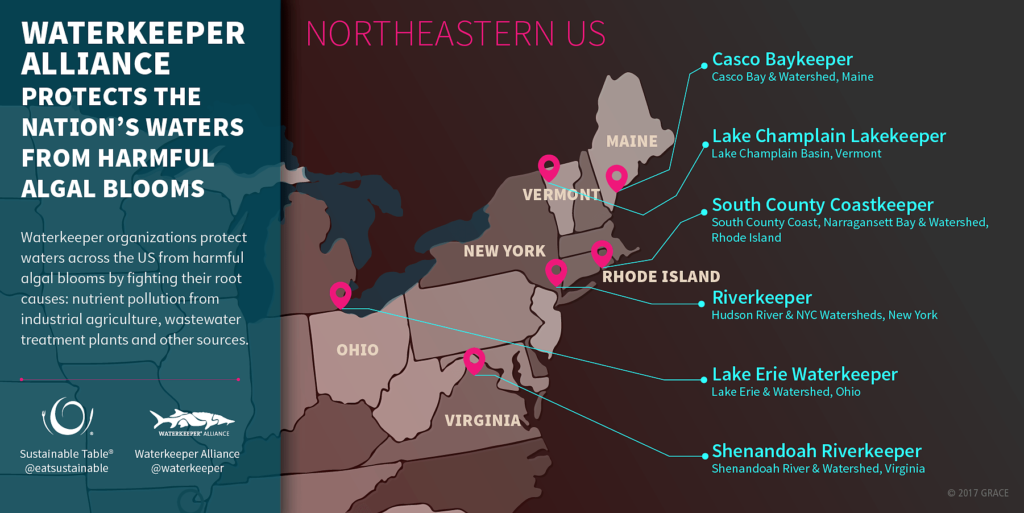
Download Northeastern US map [149k]
Casco Baykeeper, Casco Bay and Watershed, Maine
Casco Baykeeper is combating excessive nitrogen pollution and outbreaks of algae, often from such sources as combined sewer overflows, large passenger ships sewage discharges and contaminated agricultural and urban runoff.
Lake Champlain Lakekeeper, Lake Champlain Basin, Vermont
The Lake Champlain Lakekeeper works to clean up nutrient pollution from farming, land erosion and urban runoff which produce toxic blue-green algal blooms and lead to beach closures, public health issues and fishkills.
South County Coastkeeper, South County Coast, Narragansett Bay and Watershed, Rhode Island
The South County Coastkeeper protects Narragansett Bay from nutrients that flow from wastewater treatment plants, septic systems and stormwater pollution to create algal blooms that deplete oxygen, damages habitat and cause fishkills.
Lake Erie Waterkeeper, Lake Erie and Watershed, Ohio
The Lake Erie Waterkeeper is focused on harmful algal blooms as the Great Lake experiences massive and sometimes toxic algae caused by agricultural pollution, stormwater overflows and wastewater discharges. The toxic algal blooms have drawn the efforts of many states and the Canadian and US national governments.
Riverkeeper, Hudson River and NYC Watersheds, New York
The Riverkeeper monitors the Hudson River and New York City watersheds that provide drinking water to nine million people, a job that includes keeping nutrient-polluted runoff out of the waters.
Shenandoah Riverkeeper, Shenandoah River and Watershed, Virginia
The Shenandoah Riverkeeper watches farming practices to prevent algal blooms and nutrients from washing into waterways, much of it from animal factory farms and the poor storage, handling and fertilizer application of manure.
Sandy Bihn, Lake Erie Waterkeeper: Lake Erie provides drinking water for 11 million people and has 872 miles of shoreline stretching along the shores of Michigan, Ohio, Pennsylvania, New York and Ontario. Lake Erie is often severely impaired by nutrient pollution resulting in massive toxic algal blooms in the Lake and many of its tributaries, such as the Maumee and Sandusky Rivers. The toxic algae is due, in large part, to concentrated and industrialized livestock production that produces massive amounts of manure, which is excessively land applied, and to fertilizer that leaches into field tiles. In 2017, thousands of fish were killed in three Lake Erie watershed streams reportedly from manure applications right before heavy rainfalls that caused ammonia runoff, depleting oxygen and killing fish. Also, in 2017, a Lake Erie public beach had 250 ppb of the algal toxin microcystin – far above the ‘do not go in the water threshold’ of 20 ppb. This follows the 2014 algal bloom that led Toledo to issue a “Do Not Drink” advisory to roughly 500,000 water users due to unsafe levels of microcystin in the treated drinking water.
Lake Erie Waterkeeper works for a healthy and economically thriving Lake Erie through education/outreach, advocacy, litigation and advancing water related technology. The current focus is to have accountable, measurable nutrient source reductions that will then target sources providing the greatest reductions at the least cost. It is estimated in the main algae contributing watershed, the Maumee, 25 percent of the nutrient sources are from manure. To reduce manure sources, there is strong advocacy to have soil phosphorous from manure to use the same crop need standards as commercial fertilizer, rather than the excessive four times currently allowed. If this and other voluntary nutrient reductions do not work, there should be a stated basin-wide Clean Water Act that lists Lake Erie as impaired, and establishes standards (TMDL) and a plan date to be triggered that holds all accountable.